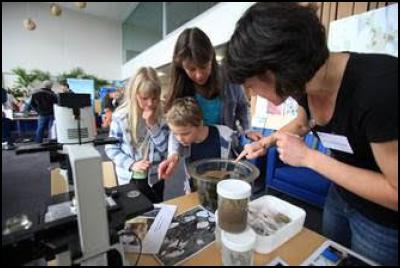DIY DNA extraction, rock snot , 3-D animation and more
DIY DNA extraction, school science projects, rock snot , 3-D animation and more on show at Open Day

Fascinating and important research happening at New Zealand’s largest independent science organisation will be on show this Sunday as part of Cawthron Institute’s fifth annual open day.
What: Cawthron Institute Open Day, free entry
Where: Cawthron Institute, EnviroTech Wing, 98 Halifax Street East
When: 10am to 2pm Sunday, July 26 2015
“Last year more than 300 people of all ages attended the open day to find out about the exciting research happening at Cawthron. We’re expecting this year will be even more popular,” Cawthron Institute Community Development Manager, Cherie Johansson says.
The event his weekend includes a mathematical 2- and 3-D water wheel installation that brings art and science together, as well as presentations by local science teachers Sarah Johns and Paul Nield. They spent six months each working at Cawthron as part of Royal Society of New Zealand’s Science Teaching Leadership Programme. There will also be pre-booked tours of the laboratory facilities where people can see science in action including learning how to do their own DNA extraction using salt, saliva, soap and alcohol.
“Lucky volunteers will be able to see their own DNA strands that have been extracted using everyday household products,” Ms Johansson says. “We’re really keen to give the public a chance to experience hands-on science, and we thought this was something they would really enjoy.”
Some interesting displays include a ‘mini’ hi-tech buoy and examples of natural toxins, didymo (also known as rock snot) and cyanobacteria or blue-green algae. Secondary school students who took part in Cawthron’s annual year 13 science workshops will also be on site displaying their science projects. Scientists from Cawthron’s freshwater, coastal science, food technology and biosecurity teams will be on hand to share and explain their work including how they are helping combat aquatic invasive species, and how satellite technology is helping their marine research and becoming an increasingly popular tool for regional councils, and recreational fishers and divers.
“Right now it’s an exciting time at Cawthron and we’re looking forward to sharing our research with the community,” Cawthron Institute Chief Executive, Professor Charles Eason, says. “These open days are a fantastic way to connect with our community and allow people to see some of the world-leading science happening in their own backyard.”
This year’s event is preceded by the first Science Careers Day at Cawthron on Friday 24 July, for around 150 secondary students from throughout the Nelson Tasman region.
“This is the first time we’ve held a careers day. Students will have the opportunity to discuss science career pathways with staff from Cawthron and some of our partner organisations, including Plant and Food Research, Department of Conservation, Real World Education, SpatNZ and NIWA,” Ms Johansson says. “It’s all part of our aim to support and inspire the next generation of New Zealand scientists.”
ENDS


 WorkSafe NZ: Conveyor Belt Death-Trap Was A Danger In Plain Sight
WorkSafe NZ: Conveyor Belt Death-Trap Was A Danger In Plain Sight Commerce Commission: 2degrees Fined $325,000 For Misleading Claims About ‘Free’ Aussie Business Roaming
Commerce Commission: 2degrees Fined $325,000 For Misleading Claims About ‘Free’ Aussie Business Roaming  Natural Hazards Commission: Hub Launched To Empower Architects And Engineers To Build Above Code
Natural Hazards Commission: Hub Launched To Empower Architects And Engineers To Build Above Code Harmony Energy: Ceremony Heralds Start Of Construction On New Zealand’s Largest Solar Farm Project
Harmony Energy: Ceremony Heralds Start Of Construction On New Zealand’s Largest Solar Farm Project Stats NZ: Annual Number Of Home Consents Down 7.4 Percent
Stats NZ: Annual Number Of Home Consents Down 7.4 Percent Plains Media: Plains FM Announces Name Change After 37 Years
Plains Media: Plains FM Announces Name Change After 37 Years



